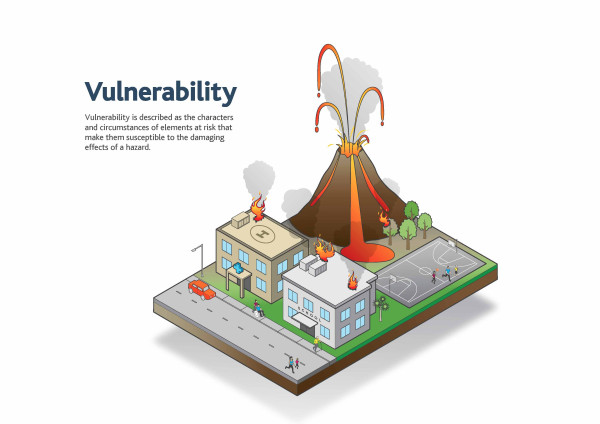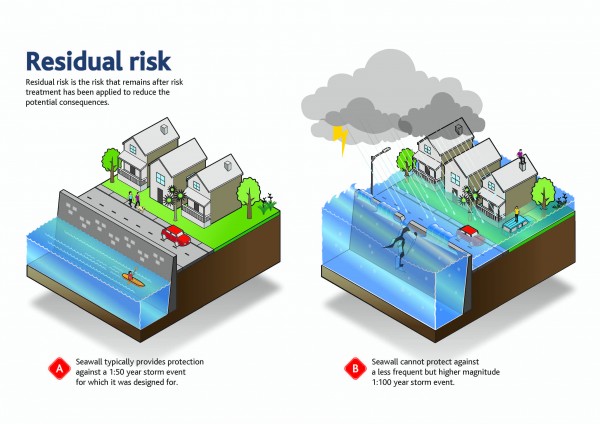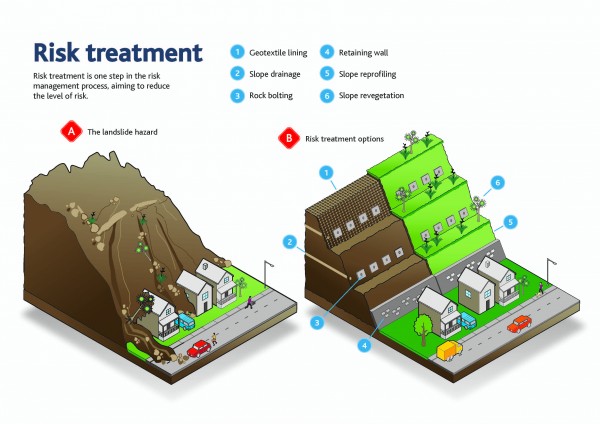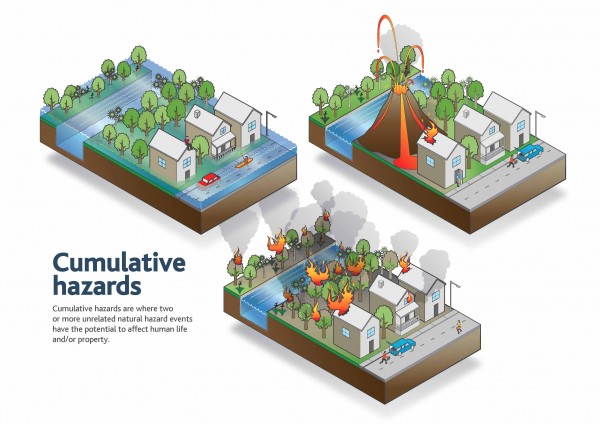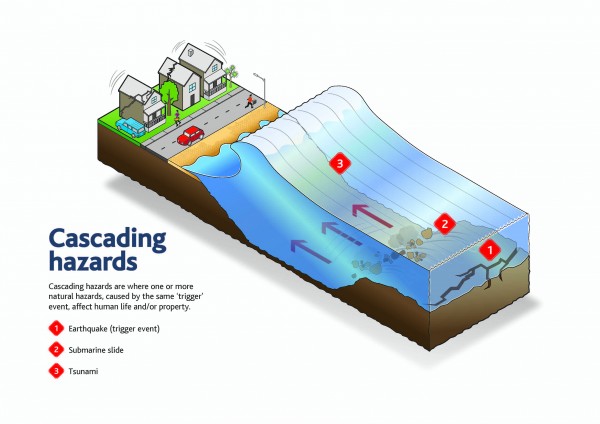Natural Hazard Risk Communication Toolbox
Auckland Council, in conjunction with GNS Science, have developed a Natural Hazard Risk Communications Toolbox. The purpose of this toolbox is to increase understanding of basic hazard and risk concepts by providing consistent content for communication materials used within council and externally to stakeholders, politicians and the community.
Staff from across the Council’s teams work with a wide range of people on various aspects of natural hazard and/or risk management. The benefit of adopting common terminology and definitions provided by this toolbox can help to foster a better understanding of somewhat complex terminology when communicating natural hazard and risk information. The toolbox contains written and visual materials to describe frequently used natural hazard risk management concepts. Some of the concepts include definitions for resilience, cumulative and cascading hazards, consequence, and hazard vs risk. For each concept the following information is provided; brief text explanations; more detailed explanations; visual representation (i.e. graphic image) and; Auckland case study (where possible).
The toolbox was created due to staff identifying common issues when it comes to communicating natural hazard and risk information. Many of the terms used for natural hazard management are highly technical or abstract in nature, and supposing subject matter expertise, making the exchange of information difficult at times. Some terms are used interchangeably whether or not they have the same or a different meaning, or they are used in the wrong context, creating misunderstanding among different audiences. With these issues in mind, the toolbox aims to provide staff with the appropriate means to communicate natural hazard information in all its forms. It provides one set of definitions which can be used to create a shared understanding within council, creating a consistent and integrated approach to communicating natural hazard risk management.
Auckland Council and the National Emergency Management Agency have been working closely together since the creation of the toolbox, as it has potential benefits for use by other councils and organisations within the CDEM and hazard management sectors.
Auckland Council Natural Hazard Risk Communication Toolbox (.pdf 3.9MB)
Vulnerability
Vulnerability is described as the characteristics and circumstances of elements at risk (e.g. human life and property) that make them susceptible to the damaging effects of a hazard.
Download this image in one of the following formats below:
| Landscape | Portrait | ||
|---|---|---|---|
| Captions | Colour | JPEG (High-res) | JPEG (High-res) |
| JPEG (Low-res) | JPEG (Low-res) | ||
| Grayscale | JPEG (High-res) | JPEG (High-res) | |
| JPEG (Low-res) | JPEG (Low-res) | ||
| No Captions | Colour | JPEG (High-res) | JPEG (High-res) |
| JPEG (Low-res) | JPEG (Low-res) | ||
| Grayscale | JPEG (High-res) | JPEG (High-res) | |
| JPEG (Low-res) | JPEG (Low-res) | ||
Changes in risk over time
Sometimes risk changes over time. This can be referred to as 'time varying risk', which is simply the consideration of increases and decreases in risk over time.
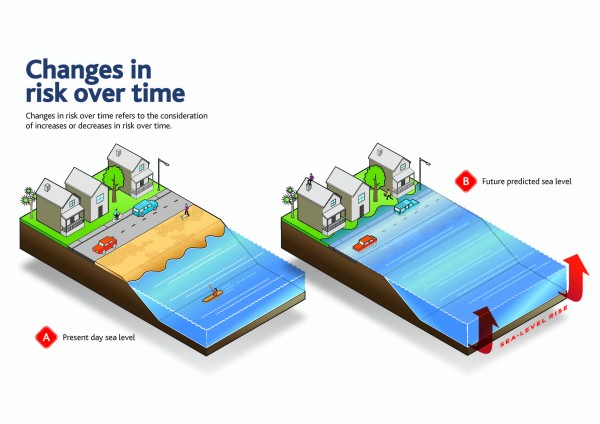
Download this image in one of the following formats below.
| Landscape | Portrait | ||
|---|---|---|---|
| Captions | Colour | JPEG (High-res) | JPEG (High-res) |
| JPEG (Low-res) | JPEG (Low-res) | ||
| Grayscale | JPEG (High-res) | JPEG (High-res) | |
| JPEG (Low-res) | JPEG (Low-res) | ||
| No Captions | Colour | JPEG (High-res) | JPEG (High-res) |
| JPEG (Low-res) | JPEG (Low-res) | ||
| Grayscale | JPEG (High-res) | JPEG (High-res) | |
| JPEG (Low-res) | JPEG (Low-res) | ||
Residual Risk
Residual risk is the risk that remains after risk treatment (i.e. through risk avoidance, reduction/mitigation, transfer or retention/acceptance has been applied to reduce the potential consequences.
Download this image in one of the following formats below:
| Landscape | Portrait | ||
|---|---|---|---|
| Captions | Colour | JPEG (High-res) | JPEG (High-res) |
| JPEG (Low-res) | JPEG (Low-res) | ||
| Grayscale | JPEG (High-res) | JPEG (High-res) | |
| JPEG (Low-res) | JPEG (Low-res) | ||
| No Captions | Colour | JPEG (High-res) | JPEG (High-res) |
| JPEG (Low-res) | JPEG (Low-res) | ||
| Grayscale | JPEG (High-res) | JPEG (High-res) | |
| JPEG (Low-res) | JPEG (Low-res) | ||
Risk Treatment
Risk treatment is one step in the risk management process, aiming to reduce the level of risk.
Download this image in one of the following formats below:
| Landscape | Portrait | ||
|---|---|---|---|
| Captions | Colour | JPEG (High-res) | JPEG (High-res) |
| JPEG (Low-res) | JPEG (Low-res) | ||
| Grayscale | JPEG (High-res) | JPEG (High-res) | |
| JPEG (Low-res) | JPEG (Low-res) | ||
| No Captions | Colour | JPEG (High-res) | JPEG (High-res) |
| JPEG (Low-res) | JPEG (Low-res) | ||
| Grayscale | JPEG (High-res) | JPEG (High-res) | |
| JPEG (Low-res) | JPEG (Low-res) | ||
Cumulative Hazards
Cumulative hazards are where two or more unrelated natural hazard events have the potential to affect human life and/or property. For example, an area may be susceptible to flooding, bush fires, and fault rupture.
Download this image in one of the formats below:
| Landscape | Portrait | ||
|---|---|---|---|
| Captions | Colour | JPEG (High-res) | JPEG (High-res) |
| JPEG (Low-res) | JPEG (Low-res) | ||
| Grayscale | JPEG (High-res) | JPEG (High-res) | |
| JPEG (Low-res) | JPEG (Low-res) | ||
| No Captions | Colour | JPEG (High-res) | JPEG (High-res) |
| JPEG (Low-res) | JPEG (Low-res) | ||
| Grayscale | JPEG (High-res) | JPEG (High-res) | |
| JPEG (Low-res) | JPEG (Low-res) | ||
Cascading Hazards
Cascading hazards are when two or more natural hazards, caused by the same 'trigger' event, affect human life and/or property. For example, a storm may result in a specific area experiencing both a tornado and flooding. Both of these have been caused by the first event.
Download this image in one of the following formats below:
| Landscape | Portrait | ||
|---|---|---|---|
| Captions | Colour | JPEG (High-res) | JPEG (High-res) |
| JPEG (Low-res) | JPEG (Low-res) | ||
| Grayscale | JPEG (High-res) | JPEG (High-res) | |
| JPEG (Low-res) | JPEG (Low-res) | ||
| No Captions | Colour | JPEG (High-res) | JPEG (High-res) |
| JPEG (Low-res) | JPEG (Low-res) | ||
| Grayscale | JPEG (High-res) | JPEG (High-res) | |
| JPEG (Low-res) | JPEG (Low-res) | ||

